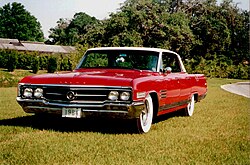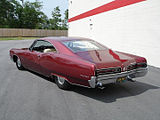Buick Wildcat
| Buick | |
|---|---|
|
Buick Wildcat Sedan (1964)
|
|
| Wildcat | |
| Production period: | 1962-1970 |
| Class : | Upper class |
| Body versions : | Sedan , station wagon , coupé , convertible |
| Engines: |
Gasoline engines : 6.6–7.5 liters (206–272 kW) |
| Length: | 5479-5593 mm |
| Width: | 2030 mm |
| Height: | 1400-1450 mm |
| Wheelbase : | 3124-3200 mm |
| Empty weight : | 1729-1912 kg |
| Previous model | Buick Invicta |
| successor | Buick Centurion |
The Buick Wildcat was an upper middle class passenger car that was manufactured by Buick from the fall of 1962 to the end of 1970 as the successor to the Invicta .
In the first year the Wildcat was only a sub-series of the Invicta, which was equipped as a two-door hardtop coupé with the high-performance version of the V8 engine with 6571 cc and 325 hp (239 kW). This engine was because of its torque of 445 ft. Lbs. known as the "Wildcat 445".
Compared to the normal Invicta, the Wildcat also had individual seats, a center console with a rev counter and automatic selector lever (TurbineDrive automatic), special decorative stripes on the vehicle sides, a vinyl roof and its own emblem: the stylized head of a wildcat on the two C-pillars. The Wildcat had the three vents on the front fenders like the Invicta and LeSabre, a design only for the 1963 model year.
As of 1963, the Wildcat was its own series, while the Invicta was discontinued. The cars no longer had the three ventilation openings from the previous year, but instead had chrome strips on the front fenders, just behind the wheel cutouts. When the Wildcat became its own series, a four-door hardtop sedan, a two-door convertible and a five-door station wagon were added. Individual seats and a center console were also available on request in the four- and five-door models.
In 1964 a four-door sedan with B-pillars was introduced; the station wagon disappeared again after a year and there were two equipment lines: standard and custom . Only in model year 1965 the Deluxe was added as a medium equipment .
From 1966 to 1969 there were only the standard (with the details of the 1965 Wildcat Deluxe generation) and custom equipment.
The 6.6 liter V8 remained as basic equipment until 1966. From 1964 to 1966 the larger engine with 6965 cm³ was also available on request, either with 340 hp (250 kW) when using the standard quadruple carburetor or with 360 hp (265 kW) when using two quadruple carburetors. Also from 1964 there was a standard three-stage automatic transmission with a steering wheel selector lever, giving buyers the choice between a manual four-speed transmission (only 1963 to 1965) or the three-stage automatic Super Turbine 400 . Interestingly, the engines were not named for their displacement (in cu.in.) but for their torque (in ft.lbs.). The Wildcat 445 was a 401 cu.in. (6.6 L), which has a torque of 445 ft.lbs. while the Wildcat produced 465 425 cu.in. (7.0 L) displacement and a torque of 465 ft.lbs. The version of the 465 with two quadruple carburetors was called the Super Wildcat .
A Gran Sport Performance Group package (option A8 / Y48) could only be ordered in model year 1966 . There were two engines to choose from: a 7.0 liter V8 with quadruple carburetors and 340 bhp (250 kW) was included in the package price, but the 360 hp (265 kW) engine with two quadruple carburetors was available at an additional cost. Originally the 20 bhp was only available as a vehicle that had been converted from a dealer (with engines with code MT), but soon the "Super Wildcats" were also available as factory-made models with the engine code MZ. Both versions (Standard and Super GS) had twin exhausts, reinforced wheel suspensions, Posi-Traction and new GS marks on the rear fenders at all Gran Sports after 1965. A total of 1,244 Wildcat GS were built by Buick in this model year. 242 of them were convertibles, the rest were hardtops. Only 22 of them were Super Wildcats.
In 1967 there was a whole new engine for the Wildcat series. As with the Riviera and the Electra 225 , a V8 with 7,046 cc displacement with quadruple carburetors and 360 hp (265 kW) was introduced, which had larger valves than the outdated, first Buick V8 from 1953. The 7.05 liter V8 was very short-lived and was only offered until 1969. In 1970 it was replaced by the largest Buick V8 with 7456 cc, which was basically nothing more than a drilled out version of the previous engine with longer cranks, which also had the larger valves and developed 370 bhp (272 kW). The torque was over 500 ft.lbs.
The Wildcat, which was only available as a custom in the last production year 1970, was replaced by the Centurion from the beginning of 1971 .
Concept vehicles
Buick has used the name "Wildcat" for five concept vehicles, three of them in the early 1950s, one in 1985 and one last 1997. Wildcat I (1953), Wildcat II (1954), and Wildcat III (1955) were Harley Earl designed , I and II still exist today.
The 1985 Wildcat was a radical mid-engined, four-wheel drive sports car with a high-performance V6 engine with twin overhead camshafts. The chassis was made of carbon fiber and vinyl ester fiber and the body had a retractable roof for passengers to get in and out of. This futuristic vehicle still belongs to Buick today and is still operational.
In 1997, Buick built a concept car called the Riviera Wildcat. This car had carbon fiber panels on the inside instead of imitation wood, blackened chrome parts on the outside and the engine was changed.
Web links
source
- Gunnell, John (Ed.): Standard Catalog of American Cars 1946-1975. Krause Publications Inc., Iola 2002, ISBN 0-87349-461-X .



